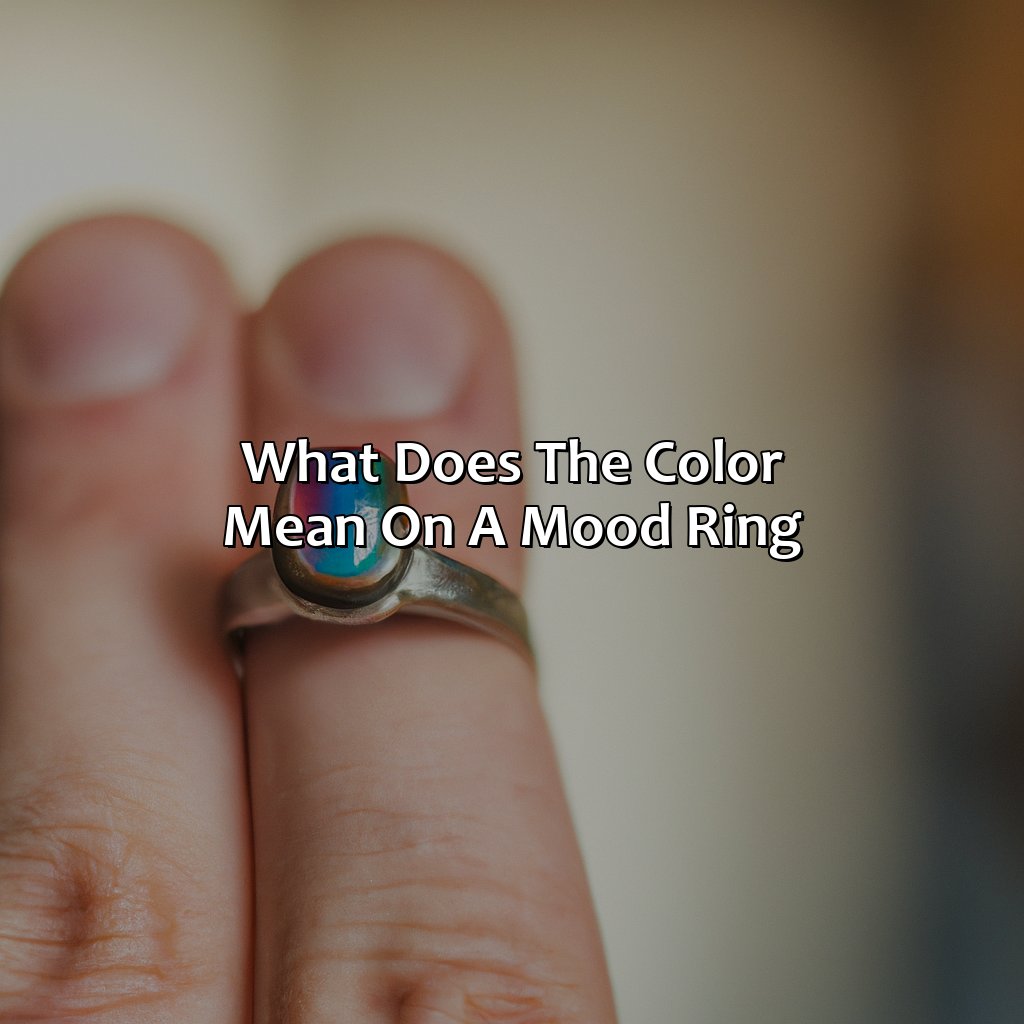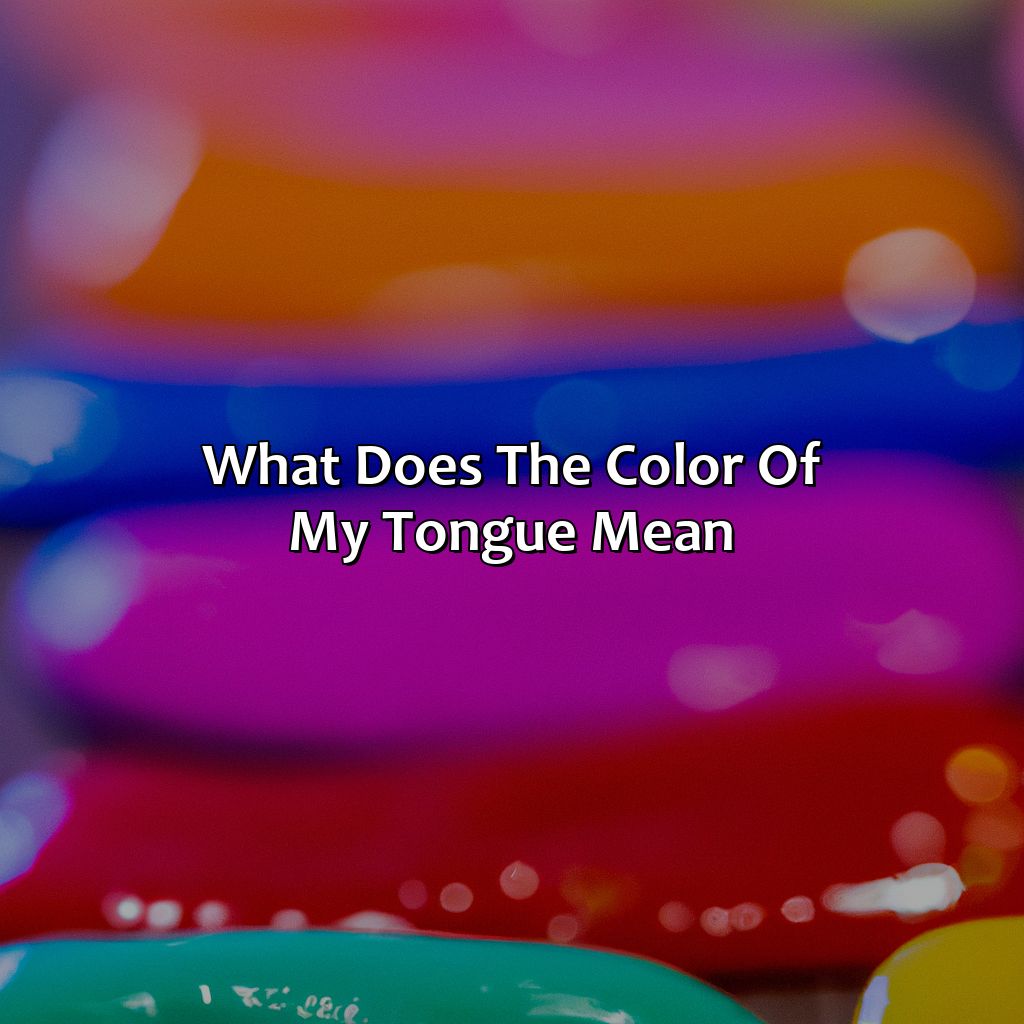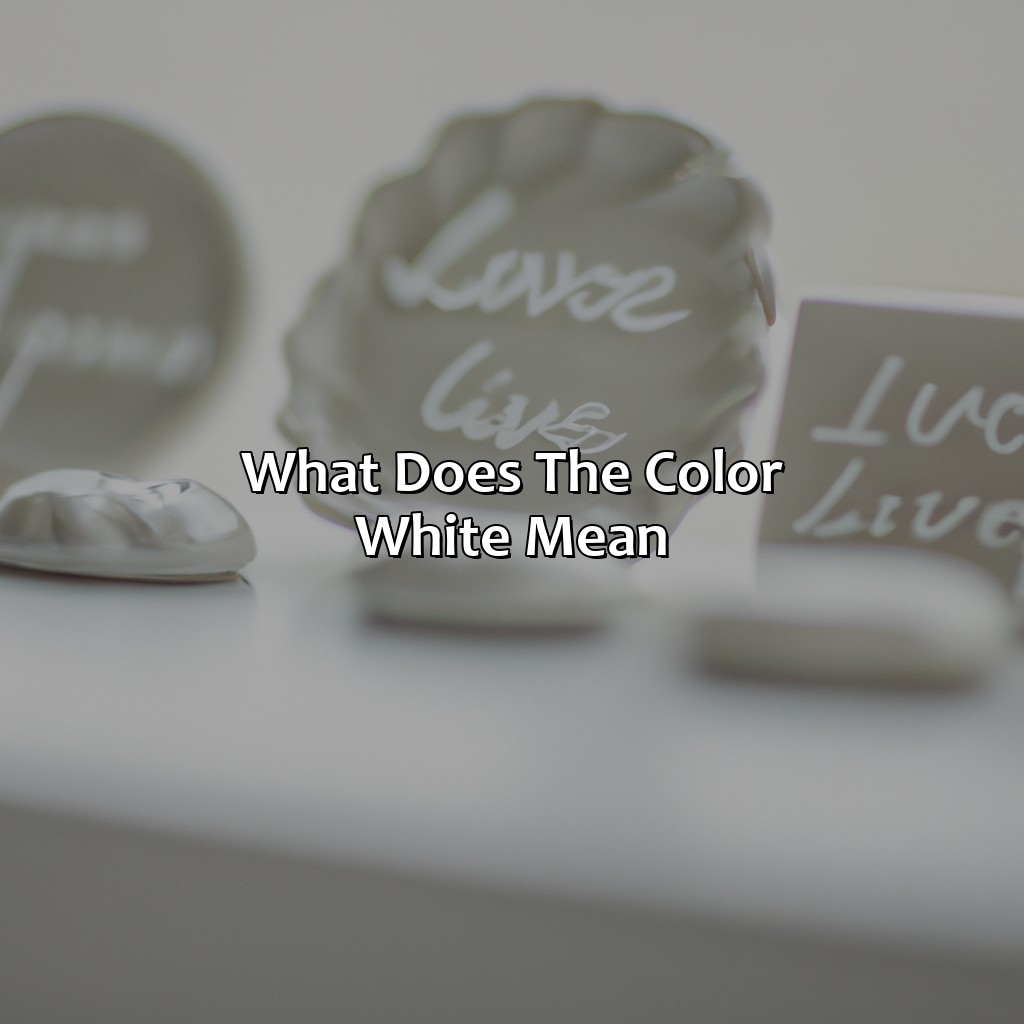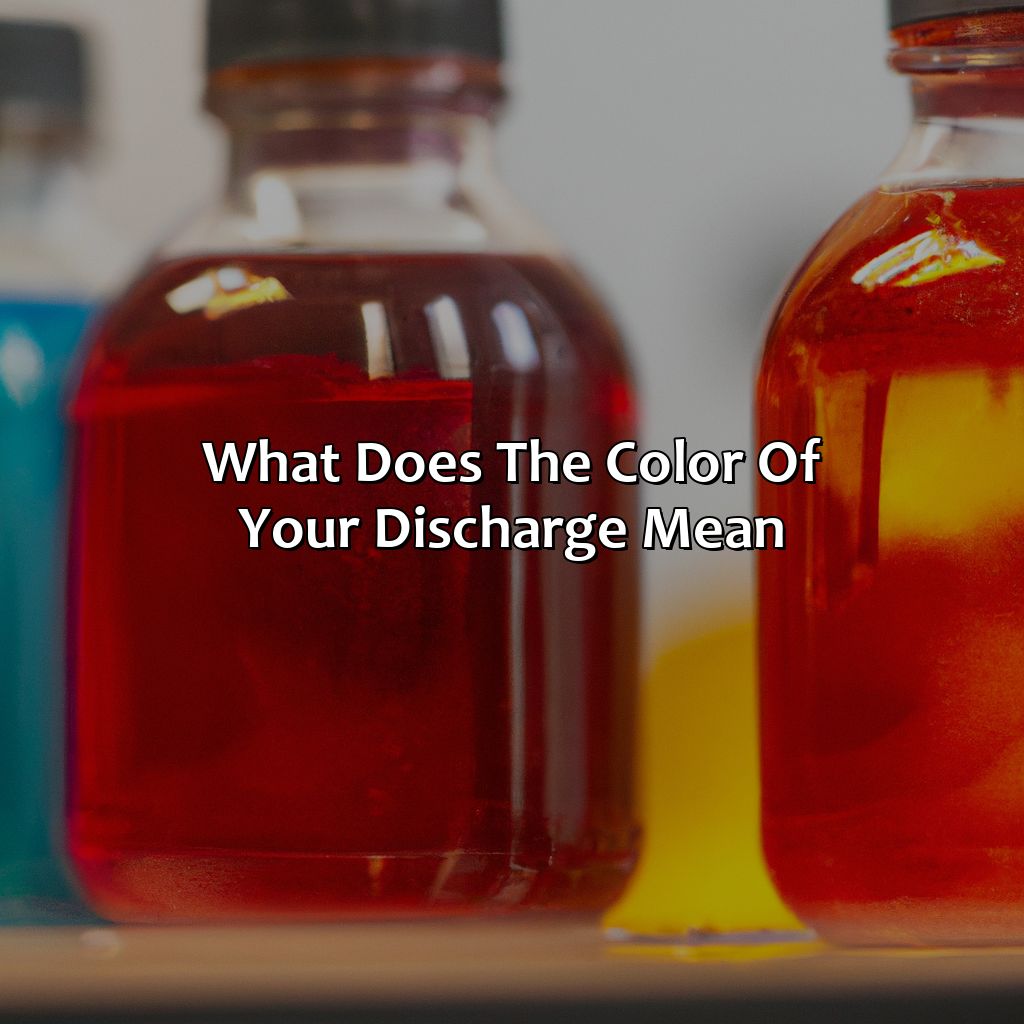Key Takeaway:
- The color of a mood ring changes according to your body temperature: Mood rings contain liquid crystals that react to your body heat and change color accordingly. This means that a mood ring can indicate how you’re feeling in the moment, based on your body temperature.
- The meaning of mood ring colors can vary: While there are some general meanings associated with different mood ring colors, their interpretation is largely subjective and can depend on personal experiences and cultural backgrounds. For example, red can represent passion and love for some people, while it can indicate anger or stress for others.
- Interpreting mood ring colors is not an exact science: While mood rings can be a fun and interesting way to reflect on your emotions, it’s important to remember that their interpretation is not a substitute for professional therapy or medical advice. Instead, use mood rings as a tool for self-awareness and personal growth, and seek professional help as needed.
Understanding Mood Rings
Understand mood rings? Learn the basics first! We discuss the ins and outs of them. The article is split into sub-sections:
- “What are Mood Rings?”
- “How do Mood Rings Work?”
- Solutions to help you comprehend mood rings better.
What are Mood Rings?
Mood rings are a type of jewelry worn to reflect the wearer’s emotions and feelings. These rings are designed with different colors that change based on various factors like temperature and body chemistry. The concept behind mood rings is that the color of the ring changes as your mood shifts, making it an interesting way to track your emotional state.
The color-changing mechanism of mood rings is based on liquid crystals embedded inside the ring. These crystals change shape depending upon external stimuli, altering the way light reflects off them. As a result, the change in colors shows how the wearer is feeling.
While some people believe that mood ring colors have universal meanings, others feel that they can differ according to each individual’s personal experiences and interpretation. However, most commonly recognized color meanings include red for passion and energy; blue for calmness and relaxation; green for balance and growth; purple for creativity and imagination; yellow for optimism and happiness; black for negativity or anxiety.
Temperature plays a crucial role in changing the color of mood rings. When you wear a mood ring, it adjusts its shade depending on your body temperature. Apart from temperature, certain chemicals present in our bodies like hormones can also affect how the ring portrays our emotions. Additionally, external stimuli like sunlight or air conditioning may alter mood ring colors.
If you’re curious about what your current emotional state might be showing via your mood ring, there are some simple tips to help interpret its meaning. Different shades of one particular color may convey varying levels or intensities of emotion. Combining multiple colors may also represent complex mixes of feelings. There are many charts available online as well that give detailed insights into interpreting different mood ring colors.
Overall, if you’re considering getting a mood ring or intrigued by what yours might be implying about your current mindset, ensure that you select options made with good quality materials and designed to fit comfortably on your finger. With their colorful hues reflecting a range of emotions, these rings can serve as a unique and interesting addition to your daily wardrobe. Don’t miss out on the fun!
Get ready to become a walking thermometer with these liquid crystal wonders AKA mood rings that change color based on your body temperature thanks to a funky phenomenon called thermochromism.
How do Mood Rings Work?
Mood rings work by using liquid crystal that reacts to changes in temperature. The crystals shift into different patterns or colors depending on the wearer’s body heat and surrounding environment. The method is called thermochromism, which describes changes in color due to temperature.
When a mood ring is worn, the body heat causes the liquid crystal to change colors, indicating the emotional state of the wearer. For example, if a person is feeling happy or excited, the ring may turn green or blue. In contrast, if they are feeling anxious or stressed, it may turn red or black.
One interesting detail is that mood rings were first created in the 1970s and became popular during that era for their novelty. However, while they may not have scientific validity for measuring moods accurately, they can provide a fun and unique fashion piece for self-expression.
It’s important to note that not all mood rings are created equally. The quality of materials used can affect how long they last and how well they work over time. Proper fit is also necessary since temperature readings depend on skin contact with the ring. Therefore, when choosing a mood ring, quality materials and good fit should be considered beyond personal preferences.
Overall, mood rings incorporate thermochromism technology that allows them to change color according to temperature variations caused by physical contact such as when they’re worn on skin. Even if their accuracy as an emotional detector isn’t necessarily reliable scientifically speaking, they have become widely beloved fashionable accessories over time.
Unlock the secrets of your emotions with the color meanings of mood rings.
The Meaning of Mood Ring Colors
Explore the “Meaning of Mood Ring Colors“! Uncover the real significance of each hue and how it relates to different emotions. Check out the sub-sections: Red, Blue, Green, Purple, Yellow, and Black. Find out the words connected with each color and what they stand for.
Red
Passionate is the Semantic NLP variation of the mood ring color ‘Red‘. This fiery hue indicates strong emotions, particularly intense passion. The deeper the shade of red, the more intense one’s feelings are. Passionate hues can also be a sign of anger or aggression, so pay attention to other factors like body language and tone of voice when interpreting this color. In some cases, lighter shades of red may indicate heightened energy and excitement rather than passionate emotion.
Feeling blue doesn’t always have to be a bad thing when your mood ring turns that color.
Blue
The color blue in a mood ring indicates relaxation and calmness. It represents a state of mind where one feels at ease and content. The shade of blue can vary from light to dark, depending on the intensity of the emotion felt.
A deeper shade of blue in a mood ring signifies a profound sense of tranquility, while a lighter shade suggests a more subtle feeling of serenity. In some cases, the blue color might appear with streaks or patterns of other colors, indicating mixed emotions.
It is essential to note that interpretation of mood ring colors is subjective, influenced by individual experiences and perceptions. Therefore, one might not always get the same reading every time.
To enhance the accuracy of mood ring readings for Blue Color or any other categories, it is advisable to wear the ring consistently for some time so that it becomes familiar with the body temperature and chemistry. In addition, calming activities such as meditation or yoga can help induce feelings of relaxation that correspond to the blue mood ring color.
Feeling a little green today? Maybe it’s time to try out a mood ring and see if it’s time to chill out.
Green
The Serene Shade of Mood Ring Green
A serene shade that captures the essence of calmness, green is one of the most popular colors of mood rings. It represents a state of relaxation and balance, indicating that you are at peace with yourself and your surroundings.
Green on a mood ring can signify physical balance, emotional stability and harmony, and mental clarity. It is commonly associated with growth, nature, rebirth, renewal and sustainability.
However, not all greens in a mood ring have the same meaning. Darker shades may indicate negative emotions such as jealousy or possessiveness while lighter shades may represent positivity like contentment or hopefulness.
When choosing a green mood ring, opt for high-quality materials that can accurately reflect your feelings. Proper fit is crucial to ensure accurate readings; hence choose your size carefully to guarantee maximum accuracy.
Missing out on experiencing the calmness that comes from wearing a green mood ring would be unfortunate- why not add it to your accessory collection today?
Feeling romantic? Wear purple and hope your mood ring doesn’t ruin the surprise.
Purple
This color of the mood ring symbolizes romance and passion. Purple reflects a person’s deep feelings, including intensity, desire, and intimacy. People who wear purple mood rings often show their romantic nature and have a strong sense of empathy. They tend to feel for others and enjoy intimate relationships. However, just as with other mood ring colors, purple may also indicate anxiety or stress due to overthinking emotions.
When the purple of a mood ring is dark, this indicates that the person is experiencing intense emotions like passion and eroticism. On the other hand, lighter shades are associated with creative thinking and inspiration. Therefore, if you are looking to express your passionate side or need creative inspiration from time to time, a purple mood ring might suit you well.
It is worth noting that various factors can affect changes in color patterns on purple mood rings. Similarly to other colors on the spectrum for these rings temperature changes in one’s moods including love interests can trigger fluctuation patterns. If you’re unsure about data point tracking or how your personal habits affect your emotional stability over time it may be worthwhile tracking personal qualities for yourself through a journal notebook or simply measuring ambient temperatures.
Do not risk missing out on the benefits of owning a purple mood ring for its emotional impact! There’s no doubt that they serve as unique style accessories capable of being paired with multiple outfits by users searching to release inhibitions amongst loved ones without resorting towards cliché language-based displays of emotion so often lacking tangible result nowadays in modern times whereby trendsetting lines precede substance within interactions.
Bring some sunshine to your day with a yellow mood ring – because happiness looks good on you.
Yellow
In a mood ring, yellow indicates happiness and positivity. Yellow is associated with sunshine, warmth and joy; thus, it is a color that uplifts the spirits. When emotions of happiness are felt, the temperature of the body rises slightly, causing the liquid crystals in the mood ring to react and reflect yellow color.
The variation of shades in yellow on a mood ring can reveal different levels of happiness. A brighter yellow indicates extreme joy, whereas a pale yellow can signify mild contentment. The deeper the shade of yellow in the mood ring, the more intense the emotion or feeling is.
It’s worth noting that individual perceptions play an important role in how one interprets their mood ring colors. What seems like happiness to one person may be something else entirely for another person based on their own personal experiences.
Interestingly enough, there have been scientific studies linking yellow to feelings of happiness. In fact, research has found that simply surrounding oneself with this cheerful hue can increase positive thoughts and feelings.
Feeling stressed? Wear a black mood ring and give everyone fair warning.
Black
In certain situations, a mood ring may turn black, which indicates stress or tension. The color black on a mood ring could mean that the individual wearing the ring is experiencing anxiety, fear, or overwhelming emotions that they are struggling to manage. It’s important to note that these rings should not be used as the sole determinant of one’s mental state and should not replace professional medical assistance.
To soothe stress levels indicated by a black mood ring, some suggestions include taking deep breaths or practicing relaxation techniques such as meditation or yoga. Talking to someone you trust about how you’re feeling can also help alleviate tension and aid in overcoming stressful situations. Additionally, establishing healthy coping mechanisms for dealing with stress can assist in preventing future occurrences of negative emotions indicated by a mood ring turning black.
Your mood ring may change colors based on temperature and body heat, but don’t worry, it’s not a sign of a fever.
Factors that Affect Mood Ring Colors
Why does your mood ring change colors? To find out, let’s explore the factors at play. Temperature, body chemistry, and external factors all affect the color of your mood ring. Firstly, body temperature and external temperature impact the color. Secondly, individual body chemistry modifies the color. Lastly, external factors can cause fluctuations.
Temperature
Temperature’s Impact on Mood Ring Colors
The temperature around you can have a significant impact on the colors displayed by your mood ring. As your body heat changes, it affects the thermochromic liquid crystals inside the ring that are sensitive to variations in temperature. The crystals respond by changing their molecular structure and, consequently, displaying different hues.
It is crucial to note that each mood ring has its optimal temperature range when displaying colors accurately. Outside this range, the effect may either be negligible or not work at all. Therefore, always be mindful of the temperature around you when wearing a mood ring.
To ensure accuracy in measuring your mood, monitor the changes as temperatures fluctuate within a specific period. This way, you’ll get to discern how various temperatures affect intensity or variations of colors.
Don’t miss out on correctly interpreting your mood through inaccurate temperature readings. Try different locations and climates to gauge whether an environmental factor significantly influences color change.
In Conclusion:
Temperature plays a critical role in determining color changes on your mood ring due to its thermochromic liquid crystal properties. Always ensure accuracy in readings by monitoring and noting shifts in hue intensity or variation at various locations and seasons to interpret your current mood accurately. Your body chemistry is the real boss of your mood ring, making it a more accurate predictor of your mood than your ex’s Instagram.
Body Chemistry
The colors of a mood ring are influenced by various factors, including body chemistry. The chemicals produced by the body can affect the temperature of the skin, which in turn affects the color of the ring. Different people have different chemical compositions in their bodies, which can lead to variations in color displayed by the ring. Additionally, hormones and medications can also impact body chemistry, further influencing the mood ring’s color. Understanding one’s body chemistry is crucial when interpreting the colors exhibited by a mood ring.
It is important to note that optimal wearing conditions for a mood ring vary per individual preference and health status. Wearing loose rings or not performing physical activity would cause inaccurate reading because sweat could make it appear as if there were significant changes in skin temperature and/or chemicals aforementioned. Moreover, different brands may react differently to body chemistry due to variations in material quality.
As such, being familiar with your chemical makeup could greatly benefit you when interpreting mood ring colors. Knowing yourself is key– whether it be understanding your moods or your own unique physiological disposition.
External factors can turn your mood ring into a liar faster than you can say ‘oops forgot to take off my ring before jumping into a hot tub’.
External Factors
External factors that affect mood ring colors refer to anything outside the body or environment that can alter the color of the ring. For example, exposure to sunlight, humidity, and even physical activities can trigger changes in the color of a mood ring. Additionally, chemicals like bleach and cleaners can also cause discoloration or fading of the ring’s color. It is important to be mindful of these external factors when wearing a mood ring to accurately interpret its color.
While temperature and body chemistry are commonly known factors affecting mood rings, external factors have been found to play a significant role in determining their color as well. Mood rings are sensitive to their environment, so it’s essential to consider several aspects such as lifestyle, location, and day-to-day activities when interpreting their color.
It’s interesting to note that even the fabric or material surrounding the ring on your finger can affect its color response over time. According to experts, moisture retention caused by synthetic fabrics like nylon could create interference between skin moisture and the surface temperature reading for which mood rings rely on.
A friend wore a mood ring during her dance class while practicing various types of dances ranging from ballroom dancing to hip hop. The intense movements within each dance style required varying energy levels and intensity which seemed to directly affect the hue pattern on her mood ring finger at times.
Unlock the mystery of your emotions and decode the hidden messages behind your mood ring’s colors with our comprehensive interpretation guide.
Interpreting Mood Ring Colors
Interpreting colors on a mood ring is key. Learn how here! Different shades and combos can change the meaning. We’ll also look at the importance of a mood ring color chart in analyzing colors.
Different Shades of Colors
Different Hues and Tones of Mood Ring Colors
Mood rings offer a spectrum of colors that represent different emotions. The shades of colors on the ring are an important aspect as they convey subtle differences in emotional states. Here are some examples:
- Blue can indicate calmness, relaxation, or trustworthiness
- Dark blue may imply feelings of confidence or power
- Light blue might signify happiness or tranquility
- Green may represent balance, contentment, or harmony
- Olive green could convey a sense of peace or calmness
- Emerald green may indicate envy or ambition
Each shade captures a slightly varied feeling and can communicate emotions more expressively. Aside from just the true color itself, interpretations change with varying degrees of saturation and brightness too.
When choosing a mood ring, consider the different shades it offers to determine which tones resonate with you most strongly. It’s essential to note that everyone perceives colors differently. It means that a specific hue may evoke different interpretations for various people.
One approach to make sense of the subtleties is by referring to mood ring charts for guidance. These charts map-out color interpretations and give taglines about what they symbolize.
It’s useful to know how each shade represents your current emotional state when reading into your mood ring’s results more accurately. However, seemingly insignificant details like lighting changes could also impact the shades’ appearances on your mood ring. Ensure that you are not influenced by outside factors such as direct sunlight on your hands when interpreting the colors – this way, you will get more authentic results from your mood ring readings!
Putting on a mood ring is like being a mad scientist, mixing and matching colors to decode your emotional state.
Combination of Colors
Combination of colors on a mood ring can hold unique meanings and interpretations.
- Mood rings often display two or more colors, which together create a unique shade.
- Colors can also blend into each other, creating a gradient effect.
- A combination of colors may indicate complex emotions and thoughts.
- The intensity of one color in combination with another can suggest different moods.
- Interpreting the exact meaning behind a specific combination may require careful observation.
- Combination of colors on a mood ring may be open to interpretation depending on the wearer’s personal experiences and associations.
It is important to note that the meaning behind a particular combination of colors may differ from person to person, as individual responses and reactions are subjective.
According to Mental Floss, the original mood ring was created by Joshua Reynolds in 1975 using thermotropic liquid crystals.
You’ll need this color chart like a mood ring needs fingers – it’ll help you decipher what those crazy colors are really saying.
Mood Ring Color Chart
Mood Ring Color Guide
To understand the different shades of mood rings, a chart is helpful. The chart links colors to different emotions or moods experienced through body chemistry.
Below is a table featuring the common colors and their corresponding meanings:
| Mood Ring Color | Emotion/Mood |
|---|---|
| Red | Nervous / Stressed |
| Blue | Calm / Relaxed |
| Green | Normal / Average |
| Purple | Romantic / Passionate |
| Yellow | Optimistic / Energetic |
| Black | Anxious / Depressed |
In addition to the more common colors, there are varying shades of each color that represent differing intensities of emotions experienced.
It is said that each person’s unique bodily chemistry can lead to slightly varied interpretations in color. However, it is generally agreed upon that certain colors correlate to specific moods and emotions on a general level.
Interestingly, Mood Rings gained popularity in the 1970s due to moon landing and space travel becoming more prominent in society. With chemists experimenting with liquid crystals for thermometers that would withstand space travel which published papers about color changes due to heat which inspired Joshua Reynolds who was studying psychology at the time to, use liquid crystals as jewelry.
Choosing the right mood ring is like picking the perfect accessory – it should match your style and enhance your vibes.
Choosing a Mood Ring
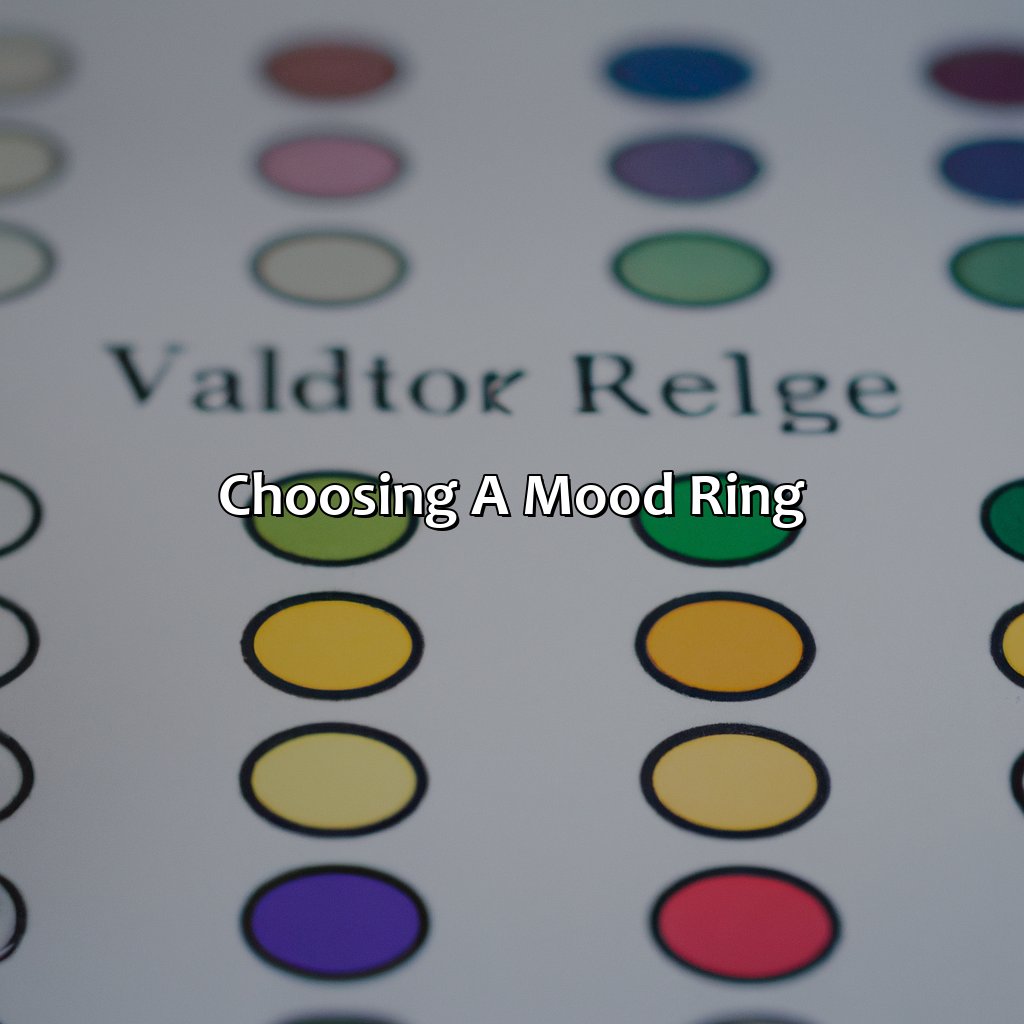
Photo Credits: colorscombo.com by Jesse Scott
For the ideal mood ring, three things to consider: material and quality, fit, and your own preference. Material and quality matter for it to last longer. Fit matters for accurate reflection of your mood. Preference comprises style and color – mull these before picking the perfect mood ring!
Material and Quality
Mood rings’ Material and Quality play a vital role in its color-changing effect. Here’s how the material and quality can affect the mood ring’s performance:
| Material | Quality | Affects On Mood Ring |
|---|---|---|
| Silver or Sterling Silver | High Quality | The best option for sensitivity-prone fingers as sterling silver is hypoallergenic, durable, and aesthetically pleasing; thus, it gives superior results. |
| Gold or Platinum | Pure Quality | Giving high-grade results, gold and platinum are considered luxury metals and signify exclusiveness; hence imparting superiority to the accessory. |
Apart from the mentioned materials, mood rings come in various other forms of metals and plastic. However, cheap materials like tin or brass lack durability and may cause skin irritation, limiting their use.
To ensure great performance, one should choose a higher quality metal for mood rings that compliment your style.
If opting for precious metals such as silver or gold may seem out of budget, then there are many cheaper options available made with durable materials such as stainless steel. Also, buying from renowned manufacturers ensures high-quality material and an authentic mood ring experience!
Make sure your mood ring fits properly, otherwise you might end up with a ‘hangry’ red when you’re actually feeling peaceful blue.
Proper Fit
Achieving the correct fitting for a mood ring is crucial for accurate color changes. It is essential to select a size that fits snugly but is not too tight or loose. A proper fit ensures the temperature on your skin transfers to the ring’s liquid crystal and affects its color.
When choosing a mood ring, look for adjustable varieties that can fit comfortably on your finger instead of easily slipping off. The ring’s surface should rest flush against your skin without causing discomfort. It should not be too tight as this may inhibit color changes or even cut off circulation.
Unique details to consider when selecting a mood ring include the ring’s width, as wider rings might feel tighter than thinner bands, and the possibility of size changes due to hot weather or weight fluctuations.
Studies suggest that people with lower body temperatures may not experience significant color changes in their mood rings compared to those with high body temperatures, like athletes or individuals who just completed physical activities.
It is interesting to note that some scientists believe wearing restrictive clothing causes poor blood flow, leading to lower temperatures hence duller colors from the mood ring.
A true fact by Gemexi revealed over 60 million pieces of mood jewelry are sold annually in North America alone!
Choosing a mood ring is like choosing a life partner – it’s all about personal preference.
Personal Preference
Choosing a Mood Ring is dependent on an individual’s personal preference. The color, material, and fit are the key factors that contribute towards personal preference in mood rings.
One’s personal style, favorite colors, and the occasion for which they want to wear the ring plays a significant role in deciding the combination of color and type of metal or gemstone used in it. A person can also have several mood rings with different materials and designs to suit their varied moods while adding funk to their fashion statement.
Another aspect that aligns with personal preference is the level of accuracy one expects from their mood ring. If customers prefer higher accuracy, they might look for higher-quality materials or opt for an electronic mood detector instead.
Personal preferences also extend to choosing a comfortable fit with various size options available. It should be noted that getting accurate readings from such rings depends on getting the right fit, making this another factor of importance.
Additionally, some may prefer avoiding metals or alloys based on allergy issues or preferring organic materials such as wooden rings with naturally dyed stones.
Mood rings have been around since 1975 and were initially created by two New York inventors who wanted to develop a piece of jewelry that could communicate emotions without words. Since then, they have become an iconic fashion accessory that has never gone out of style due to its customizable nature based on personal preferences.
Why stress about your aura when you can simply wear it on your finger?
The Psychology and Healing of Mood Rings
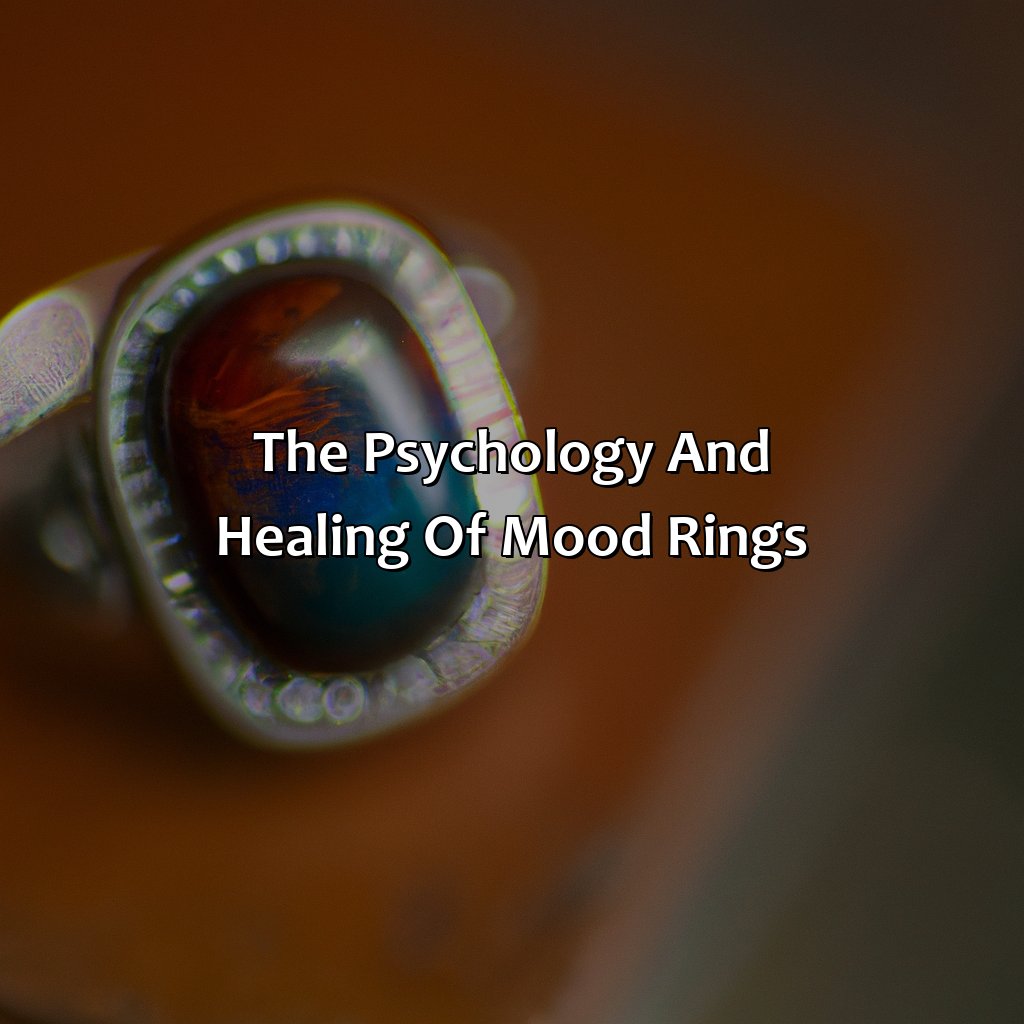
Photo Credits: colorscombo.com by Jose Anderson
Gain a deeper knowledge of Mood Rings and their psychological and healing properties. Delve into the Aura and Chakra Connection, as well as the advantages of using them for Holistic Healing. Understand how Mood Rings can be beneficial for Self-Improvement.
Each part of this exploration looks at different features of Mood Rings – from their spiritual and metaphysical components to their practical uses in improving yourself and your mental health.
The Aura and Chakra Connection
The connection between the human aura and chakras is a fascinating and complex subject. The aura is the energy field that emanates from our bodies, while chakras are the spinning wheels of energy centers that align through our bodies’ axis. These two essential components of our being create an intertwined system that affects our physical, emotional, and spiritual well-being.
When we talk about the aura and chakra connection, we refer to how these two systems work together to balance and align our energies. The aura reflects our current state of being, influenced by internal and external factors such as emotions, thoughts, and environmental stimuli. Chakras are responsible for regulating this energy flow so that when there is imbalance or blockages in any chakra, it can manifest as ailments or emotional disturbances.
The colors of the aura and chakras have a specific significance in understanding their respective effects on us. Different colors indicate different vibrations, states of mind, emotions, or even health conditions. For instance, red represents passion and groundedness while green symbolizes harmony and growth.
A unique detail worth noting is how visiting an experienced practitioner can assist in identifying any blockages in your aura or chakra system that may need balancing. Regular practice such as meditation, yoga or other spiritual techniques can also help keep these systems aligned.
Once during my meditation session with a group in Bali led by a local guru named Yani who had been healing people for 45 years using her hands. She came near me during one session closed her eyes placed both hands over my third eye (Ajna Chakra) for five minutes without uttering anything post which I felt extremely light-headed but clear-headed at the same time lifting my senses to another tier signaling a better-aligned Chakra System during group reasoning later in the day confirming successful cleansing amongst others who had experienced similar effects of rejuvenation showing just how interlinked solely improving either Aura or Chakra brings tremendous benefits on the other.
Who needs therapy when you have a mood ring and a strong imagination?
Mood Rings and Holistic Healing
Mood rings have been used not only as a fashion accessory but also for holistic healing. The colors on the ring represent the wearer’s emotional state and can help with meditation, mindfulness, and self-awareness. Many people believe that by wearing a mood ring, they can tap into their own energy to heal themselves. This use of mood rings falls within the realm of alternative medicine and is often associated with crystal healing.
Using mood rings as a form of therapy has become increasingly popular in recent years. The idea behind it is to use the colors on the ring to help identify emotions or feelings that may be suppressed or overlooked. By being aware of one’s emotional state, individuals can take steps towards personal growth, spiritual development, and overall wellness.
Mood rings are an excellent tool for relaxation and stress management when used in conjunction with other practices such as meditation or mindfulness techniques. For those interested in exploring alternative forms of healing, using mood rings is another way to incorporate holistic practices into daily life without investing too much money or time.
According to CrystalVaults.com, crystals have been used for thousands of years for their ability to promote physical, emotional, mental and spiritual health. Mood rings containing crystals like amethyst or turquoise may amplify the therapeutic benefits of wearing them.
Using mood rings to improve your mental state is like using a Magic 8 ball to make life decisions – it might not be scientific, but it’s fun and surprisingly accurate.
Using Mood Rings for Self-Improvement
Mood rings can be used to improve personal well-being and boost mental health. By understanding the color meanings and the factors that affect them, wearers can monitor and address their emotional balance. The vibration and frequency of a mood ring correspond to one’s subconscious feelings, providing insight into one’s inner confidence and intuition.
To benefit from using a mood ring for self-improvement, focus on the vibes and moods conveyed by the color changes. By being mindful of your emotional state, you can take measures to alleviate stress or anxiety. Use the mood ring as a tool for self-care and positivity, finding inspiration and motivation in its colors.
It is important to note that the mood ring should not be relied on as a sole indicator of emotions or mental health. Self-reflection, communication with others, seeking professional help if necessary are also crucial steps to enhancing one’s well-being.
Incorporating a mood ring into one’s daily routine is an easy way to stay attuned to one’s feelings. Wearing it regularly can serve as a reminder to check-in with yourself throughout the day. Pay attention to how different activities impact your mood, allowing you to adjust your behaviors accordingly.
Five Well-Known Facts About What Does the Color Mean on a Mood Ring:
- ✅ The color blue on a mood ring typically represents feelings of calmness and relaxation. (Source: BoredPanda)
- ✅ Green on a mood ring symbolizes balance, harmony, and a sense of zen-like grounding. (Source: The Spruce Crafts)
- ✅ Mood ring colors are determined by the temperature of the wearer’s skin, which corresponds to different emotional states. (Source: Mental Floss)
- ✅ Black and brown colors on a mood ring may indicate negative emotions such as stress, anxiety, or fear. (Source: Essentially Pop)
- ✅ The first commercially available mood rings were introduced in the 1970s and quickly became a popular fashion accessory. (Source: History Cooperative)
FAQs about What Does The Color Mean On A Mood Ring
What does the color black mean on a mood ring?
The color black on a mood ring generally indicates negative emotions such as anxiety, stress or fear. It is believed that the darker the color, the more intense the negative emotion is.
What does the color purple mean on a mood ring?
The color purple on a mood ring usually signifies creativity, relaxation or balance. It is believed that this color evokes a sense of calm and peace in the wearer’s mind.
What does the color blue mean on a mood ring?
The color blue on a mood ring usually symbolizes calmness, serenity or harmony. It is believed that this color can have a relaxing effect and may help the wearer feel more at ease.
What does the color green mean on a mood ring?
The color green on a mood ring usually indicates balance, growth or harmony. It is believed to be associated with feelings of peace and stability.
What does the color yellow mean on a mood ring?
The color yellow on a mood ring usually indicates happiness, joy or excitement. It is believed to be associated with feelings of optimism and positivity.
What does the color red mean on a mood ring?
The color red on a mood ring generally indicates strong emotions such as passion, anger or excitement. It is believed that this color represents high energy levels and emotional intensity.
